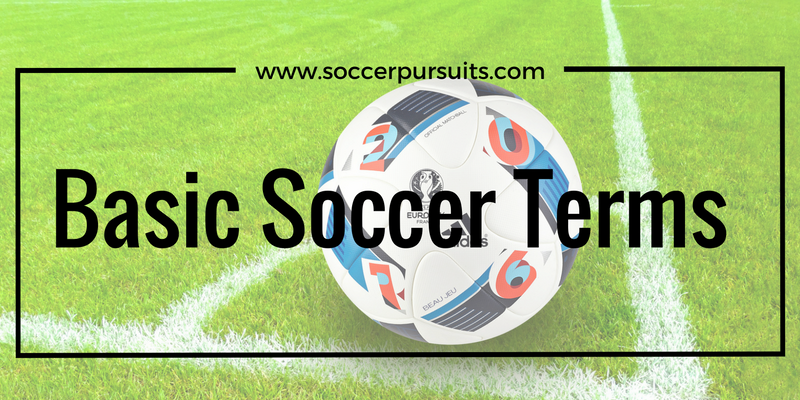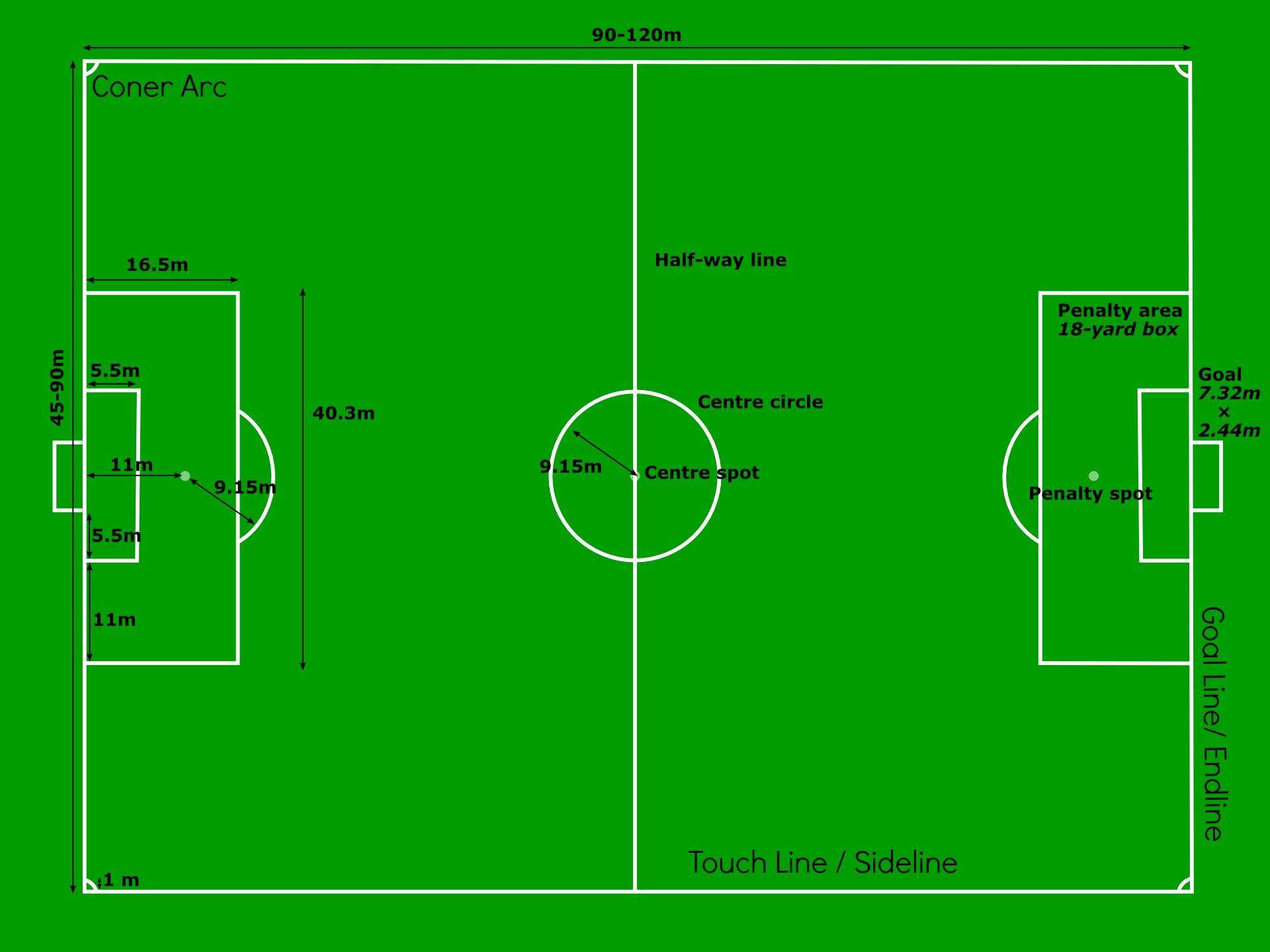Discover the basic soccer terms, laws, and rules everyone needs to know. It’s a handy list all about the basic soccer terms, laws, and rules for the field, players, and the game.
Familiarize yourself with the vocabulary before you head off to tryouts, practice, or the soccer game.
Now let’s get back to the basics and learn everything there is to know about the sport itself.
Basic soccer terms and rules for kids, youth, parents, and beginners.
These are the soccer terms used by the officials and basic rules or laws of the game. It also includes infringement terms that will be helpful for you to know.
1. Regulation time: The length or regulation time for a soccer game is 90 minutes; 45 minutes for the first half, and another 45 minutes for the second half.
2. Advantage: Awarded if a foul is committed, but the offended team still maintains possession of the ball, especially when it is a goal-scoring opportunity. No foul is called, but the play continues on.
3. Dangerous Play: If the referee determines an action made by a player could possibly harm him/herself or the opponent. An indirect free kick is awarded.
4. Foul: When the act of player harms an opponent or was unfair in the sport of play, a foul is awarded.
5. Handball: Using any part of the arm below the shoulder to make contact with the ball. Does not include the goalkeeper, unless outside of the penalty area.
6. Yellow Card: Informally known as a “caution”, can be awarded for:
Unsporting behavior, persistently breaking the rules by the same player, not abiding by the proper distance away from the ball when a free kick or throw-in is being taken, delaying the restart of play, etc.
7. Red Card (direct or two yellow cards): When awarded to a player, the player must immediately leave the game, leaving their team playing with ten players instead of eleven. It is used for:
serious foul play, violent conduct, spitting, using their hands to stop a direct attempt at goal, a foul from the last defender before the goalkeeper, and using offensive/threatening language, typically aimed at another player or the referee.
8. Offside: When a player has the ball played to him/her and he/she is already past the second-to-last defender (including the goalkeeper) before the ball was kicked, the player is offside. The play must occur in the attacking half of the field.
Watch the video below to get a better explanation and understanding of the offside rule.
9. Obstruction: Impeding the progress of an opponent to the ball. In other words, defending the player and not the ball. Think of screening in basketball.
10. Sudden Death/ Golden Goal: An overtime period in which the game is immediately finished once a team scores a goal.
If it is sudden death, or regular two periods of overtime, or penalty kicks, vary from league-to-league, and also tournament to tournament.
11. Injury Time: The amount of stoppage time after regulation time is finished, in which the game continues because of injuries, etc.
Soccer terms, laws, and rules for game restarts.
On all of these restarts, the player who touches the ball first cannot touch the ball again until it is touched by another player.
1. Kick-off: To start each half (the team that has the ball is determined by a coin toss) and after each goal is
scored. The teams stay on their respective halves.
Once a goal is scored, the opponent (the team who got scored on) starts with the ball at the center of the field. A goal can be scored straight from the kick-off!
2. Free Kick: Awarded to the team when a foul is committed against them where the foul occurred. Opposing players must stay 10 yards away from the spot of the penalty. There are two types of free kicks:
a. Direct: A goal CAN be scored directly from the free kick taker. Another type of Direct Free Kick is a Penalty Kick.
b. Indirect: A goal cannot be directly scored. Another player must touch the ball first before the shot.
3. Penalty Kick (PK): A free kick located inside the penalty area. All other players besides the goalkeeper and the PK taker must stay outside the borders of the area.
If the kicker misses, he/she cannot touch the ball again until another player also touches the ball (can be on the other team, i.e., the goalkeeper)
4. Corner Kick: Awarded to the attacking team when the defending team last touches the ball before it goes over the goal line. The ball is placed in the corner arc (on the side where the ball went out). Opponents must stay 10 yards away from the ball.
The ball is placed in the corner arc (on the side where the ball went out). Opponents must stay 10 yards away from the ball.
5. Goal Kick: Awarded to the defending team when the attacking team last kicks the ball over the goal line. The attacking team must stay out of the goal area (18-yd. box).
6. Throw-in: When the ball completely crosses over the sideline, the team that did not touch the ball last is awarded a throw-in.
From where the ball went out, the player throws the ball in, with two hands on the ball, overhead and both feet must be touching the ground. You cannot score a goal from a throw-in.
7. Punt/Drop Kick: Taken by the goalkeeper after a save is made. The ball is dropped or thrown slightly by his/her hands and then kicked down the field. The goalkeeper can also throw the ball back into play.
8. Drop Ball: Used to restart play when play was stopped while the ball was within the borders of the field. Normally one player from each team joins the referee where the ball was stopped.
The referee drops the ball from waist-height and the players must wait until the ball makes contact with the ground before touching the ball.
For good sportsmanship, if there was an injury, one team kicks the ball out, awarding the injured team a throw-in.
9. Substitution: When one or more players are switched from on the field to off.
Differentiation between leagues and tournaments on the limitation of how many players, a substitution is allowed at a stoppage of play from the center line and only once the referee has acknowledged the player.
Soccer terminology for the different positions.
1. Goalkeeper/ Goaltender/ Keeper/ Goalie: Prevents the opponents from scoring, it is the only position that allows a player to use their hands while on the field within the penalty area.
2. Defender(s) / Back Four – center back, stopper, sweeper, fullback: These players mark the opposing team, and last line before the goalkeeper. The first line of offense to create attacking situations.
3. Midfielder(s) – center midfielder, defensive/attacking center mid, outside midfielder/winger: Between the two other lines, the main job is to be the playmakers and help transition the game from a defensive situation to an offensive.
4. Forward(s) – center forward, second striker: The highest line up the field, tailored to scoring goals and also being the first line of defense.
Soccer formations.
1. Formation: The arrangement of players situated and positioned on the field, describing the various lines of positions (defense, midfield, forwards). I.e., 4-4-2, 4-2-3-1, 4-3-3
The video below describes the various positions on the field and the different formations:
Terminology for soccer officials (referees).
1. Referee (center): In charge of regulation of the game, the players, material and following through with specific actions taken according to the rules.
The referee is the official timekeeper and holds the power to call fouls, offsides, cards, ejections, stoppage and restart, goals, etc. You will see him/her in the middle/ center of the field when the game is about to start.
2. Linesman (Assistant referee): Assistant referee, runs the length of the sideline but stays on only one half. The other half on the other side of the field is occupied by the other linesman.
They assist the referee to call offsides, and out-of- bounds. The linesman can alert referee of a foul or handball. Linesmen are normally used for regulation of substitutions when a fourth official is not present.
3. Fourth official ( fourth referee): The fourth official assists the linesmen and referees. They also make all substitutions and can replace either of the 3 referees if needed.
Soccer field parts terminology.
This section will show you the different parts of the soccer field and terms that you need to know about a soccer field.
1. Far Post: The post of the goal furthest away from the play, or the ball. Also, is used for a run that is made by the players when a cross is played in where the player runs to that area in front of the post.
2. Near Post: See Far Post, but the post closest to the play or the ball.
3. Sidelines/Touchlines: The borderline of the field where the Linesmen are placed and when the ball is out, a throw-in occurs.
4. Goal Lines: The borderline of the field on which the goals sit.
5. Goal/ Net: The target on which the teams are attempting to score, consists of goalposts and crossbar.
6. Penalty Area/Penalty Box/18-yard box: The bigger box around the goal, in which the goalkeeper is permitted to use his/her hands.
7. Goal Area/ 6-yard box: The smaller box around the goal where the goal kicks are taken from.
8. Center Circle: Circle in the middle of the field where the opposing team must stay out of during a kick- off.
Click on the image below to get a better view of a soccer field.
Types of soccer skills terms
These are the soccer terms or techniques used during the game by the players.
1. Chip: A short kick lofted in the air.
2. Flick: Where a player quickly and off his/her first touch, hits an already moving ball without trapping it first.
3. Save: When a player stops an attempt at goal, can be a field player (not using hands), or a goalkeeper (can use hands).
4. Shielding: Term used to describe when a player places his/her body between the opponent and the ball.
5. Diving: An attempt by a player to draw a foul, where he/she falls to the ground when no foul was committed or the referee had not seen a foul being committed. Also known as flopping.
6. First touch/ Trap/ Trapping: The first contact that a player has with the ball. Used with any part of the body, except for the arms, a player receives the ball and brings it under control.
7. Give and Go/ One-Two/ Wall pass: When a player passes a ball to a teammate and receives the ball back. Usually, it occurs around a player of the opposing team.
8. Cross: A pass, whether on the ground or in the air, that is played across the face of the goal, or into the goal area, giving the team a chance to score.
9. Slide Tackle: A tackle made on the ground with one foot (legal, two-footed is illegal, also from behind the player is illegal) where the player slides on the surface of play and makes contact with the ball.
10. One Touch Soccer: Used for the type of rapid soccer played when the first contact of each player is already a pass to another player. Usually, the ball stays on the ground.
11. Nutmeg: A skill where the ball is kicked through the open legs of an opponent and controlled on the other side.
12. Heading/ Diving header: When a player uses their head to control, shoot or pass the ball. A diving header is when the player launches him/herself into the air, closer to the ground towards the ball and makes contact with his/her head.
13. Bicycle Kick: The player jumps in the same motion as a backflip, and makes contact with the ball with their feet, shooting the ball behind them.
14. Scissor Kick: A kick performed in the air when the player jumps in the air with one leg and propels the other leg to make contact with the ball.
15. Cutback: A sharp movement in the opposite direction when a player is dribbling the ball.
16. Dribbling: Keeping control of the ball while running using the player’s feet.
17. Juggle: Keeping control of the ball while it is in the air where all parts of the body are used.
Dialogue of players
Terms used on the field by the players to one another, or from the coaches to the players.
1. Man-on: A warning that is given from one teammate to his/her other teammate to notify them that an opposing player is coming to attack from behind.
2. Hat trick: Refers to a single player that scores three goals within the same match.
3. Step Up: Usually, when the ball is out of danger and your team can move forward as a unit.
4. Dummy: A particular player or movement that deceives the other team in thinking that they will receive the ball. Used to lure the defenders away from the player who the ball is actually intended for.
5. Mark (Man marking), (see Man-on): To defend a player, by following them, keeping yourself close to them, and trying to stop them from having the ball.
6. Goal Side: Used when marking, usually on a corner or free kick, the defending player should be on the side of the attacker that is closest to the goal they are defending.
7. Plays on the field: A variety of combinations that can occur on the field during play.
8. An Assist: The player to last touch the ball before the goalscorer (another player) scores the goal.
9. Wall: A formation made of players in front of a free kick-off the opposing team to try to block the shot. The wall must be ten yards away from the spot where the kick is being taken.
10. Breakaway: The attacker has broken away from opposing defense, leaving only the goalkeeper between him/herself and the goal.
11. Fifty-Fifty Ball: A fair tackle between two opposing players in which they have an equal chance of gaining possession of the ball.
12. Overlapping Run: A run made by a player around their teammate with the ball.
13. Offside Trap: Where defenders step forward at the same time to catch the attacking player in an offside position.
14. Back Pass: A pass that a player makes towards their own defending goal. If an intentional back pass occurs to the goalkeeper, the goalkeeper is NOT allowed to pick the ball up with his/her hands.
15. Own Goal: A goal scored by the defending team into their own goal.
16. Square Ball: A ball played parallel to the width of the field.
17. Through Pass: A ball played by the attacking team between the defenders to give a chance for their teammate to run onto so he/she is not offside.
18. Pinnie / Bib: A shirt or sleeveless cover used for a team during practice or in younger ages, if the colors of both teams are the same or similar. Also used in younger ages for the goalkeepers, if no other shirt/jersey is provided.
Final thoughts
As a kid or beginner, knowing these soccer terms, laws, and rules will help you to better understand the game.
As a parent, making your way into the world of soccer, (where the soccer moms are prepared with orange slices, the referees are whistling repeatedly at your child, and carpooling is your worst nightmare) can be a scary journey.
Although you might still be unsure of who’s turn it is to bring water and juice boxes for the kids, at least you can explain the offside rule to another soccer mom or dad.
We hope you found this list of soccer terms, laws, and rules for kids, youth, parents, and beginners helpful.
Do you have any terms or rules you would like us to include in this post? Share them in the comments below.
Image via Stux and Openclipart


